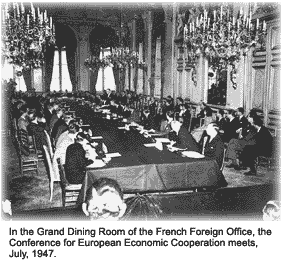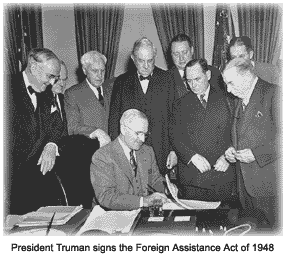"The modern system of the division of labor upon which the exchange of products is based is in danger of breaking down. The truth of the matter is that Europe's requirements for the next three or four years of foreign food and other essential products -- principally from America -- are so much greater than her present ability to pay that she must have substantial additional help or face economic, social, and political deterioration of a very grave character."
- Secretary of State George C. Marshall describing the goals of the Economic Recovery Plan,
June 5, 1947 at Harvard University.
Introduction
The United States and its allies, the victors of World War II, took steps to reverse mass disintegration among the people of Europe, including Turkey. To clear away the damage in those areas as quickly as possible and to begin economic reconstruction, the Economic Cooperation Act of 1948 (Marshall Plan) was implemented. The United States included the former enemies, Germany and Italy, in its plan — thereby preventing a reprise of the worldwide economic depression of 1929. The Marshall Plan also laid the foundation for the North Atlantic Treaty Organization (NATO) and the eventual unification of European countries (European Economic Union). Europe in 1945 lay in ruins, many of its cities demolished, its economies devastated. Its war survivors, millions of them displaced, faced famine. The period also marked the inception of The Domino Theory (the fall of one country after another to communism) and the resultant attempts to “contain” communism in the Cold War. The Soviet Union's hegemony over Eastern Europe, and the vulnerability of Western European countries to continued Soviet expansionism, sharpened the sense of crisis. Rooted in FDR's Four Freedoms Speech, the Marshall Plan was not originally intended to be a weapon to fight communism, but it became a bulwark of American foreign policy to manage communist containment on the Continent, as outlined in the Truman Doctrine, during the Cold War.Instrumental in crafting the Marshall Plan was George Kennan, leader of the State Department's Policy Planning Staff under Marshall and Acheson. Kennan was charged with the responsibility for long-term planning.
 Background
Background
The demise of Axis political and military power left a vacuum in the areas of international life where that power had asserted itself. The Allies got nowhere with Russia on peace treaties, because they had been unable to agree on how that vacuum should be filled. The American view was that new and liberalized political governments should rise from the totalitarian rubble. The former Axis countries would remain demilitarized and under close allied supervision, but would otherwise enjoy national independence. The Soviets under Stalin were determined to see new regimes emerge that would be dominated by communists subservient to Moscow. That would give the Kremlin effective control over the military and industrial power of those countries, and it would help them to dominate surrounding regions as well.
The Economic Cooperation Act
In a speech on June 5, 1947, U.S. Secretary of State George Marshall proposed that European nations should create a plan for their economic reconstruction and that the United States would provide economic assistance. In practical application, the proposal involved the constructive solution of thousands of detailed problems of international life. While attempting to go ahead with the program, the American government found itself temporarily blocked by the inability of the other Allies to reach agreement on the terms of treaties of peace with the major axis countries: Germany and Japan. On December 19, 1947, President Harry S. Truman sent a message to Congress that followed Marshall’s ideas to provide economic aid to Europe. After lengthy hearings in the House Foreign Affairs Committee — and an alarming Soviet-backed coup in Czechoslovakia on February 25, 1948 — the Economic Cooperation Act was resoundingly passed by a vote of 329 to 74. On April 3, 1948, President Truman signed the act that became known as the Marshall Plan.
 Participating countries included Austria, Belgium, Denmark, France, West Germany, Great Britain, Greece, Iceland, Italy, Luxembourg, the Netherlands, Norway, Sweden, Switzerland, and Turkey.
Congress appropriated $13.3 billion during the life of the plan for European recovery. That aid provided much-needed capital and materials that enabled Europeans to rebuild the European continent’s economy. The Marshall Plan provided markets for American goods, created reliable trading partners, and supported the development of stable democratic governments in Western Europe. Congress’s approval of the Marshall Plan signaled an extension of the multilateralism of World War II into the postwar years. The plan was to terminate on June 30, 1952, with a possible 12-month extension. The plan was not a simple cash handover, but the temporary creation of an entire bureaucratic structure and extension of American government management in Europe. The generosity and commitment of the United States to its European allies during World War II, plus the Marshall Plan, made the European Union of today possible.
Participating countries included Austria, Belgium, Denmark, France, West Germany, Great Britain, Greece, Iceland, Italy, Luxembourg, the Netherlands, Norway, Sweden, Switzerland, and Turkey.
Congress appropriated $13.3 billion during the life of the plan for European recovery. That aid provided much-needed capital and materials that enabled Europeans to rebuild the European continent’s economy. The Marshall Plan provided markets for American goods, created reliable trading partners, and supported the development of stable democratic governments in Western Europe. Congress’s approval of the Marshall Plan signaled an extension of the multilateralism of World War II into the postwar years. The plan was to terminate on June 30, 1952, with a possible 12-month extension. The plan was not a simple cash handover, but the temporary creation of an entire bureaucratic structure and extension of American government management in Europe. The generosity and commitment of the United States to its European allies during World War II, plus the Marshall Plan, made the European Union of today possible.
To become eligible for assistance under the act, each participating country was required to conclude an agreement with the United States Government that committed it to the act's purposes. Participants stabilized their currency, promoted production, cooperated with other participating countries in the interchange of goods, furnished the United States with needed materials, submitted progress reports and took other measures to expedite a return to economic self-sufficiency.
Non-European countries affected
 Under provisions of title IV of the Foreign Assistance Act of 1948, China and Korea, although not participants in the Marshall Plan, were furnished assistance in a similar manner. After January 1, 1949, the ECA took over from the U.S. Army the administration of the program for relief and economic rehabilitation of Korea. The view by the Truman Administration in the spring of 1948, of the on-going Chinese revolution was that the Communists under Mao Zedong would fail to control China with one government, if they won over the Nationalists under Chiang Kai-shek at all. In either case, non-industrialized China still struggled to shed centuries of feudalism and was judged incapable of mounting any threat to the western hemisphere.
Under provisions of title IV of the Foreign Assistance Act of 1948, China and Korea, although not participants in the Marshall Plan, were furnished assistance in a similar manner. After January 1, 1949, the ECA took over from the U.S. Army the administration of the program for relief and economic rehabilitation of Korea. The view by the Truman Administration in the spring of 1948, of the on-going Chinese revolution was that the Communists under Mao Zedong would fail to control China with one government, if they won over the Nationalists under Chiang Kai-shek at all. In either case, non-industrialized China still struggled to shed centuries of feudalism and was judged incapable of mounting any threat to the western hemisphere.
The communists did win the civil war in China. Mao declared formation of the People's Republic of China on October 1, 1949. The Soviet Union was the first country to recognize the PRC. While other countries recognized the new government, the United States, vigilant against the spread of communism, refused to formally recognize the People's Republic until three decades later with the visit of President Richard M. Nixon. Until that visit, the American government recognized only the Nationalist government on Taiwan as the legitimate government of China.
The Marshall Plan benefited the American economy as well. Marshall Plan money was used to buy goods from America, and the goods had to be shipped across the Atlantic on American merchant vessels. By 1953 America had pumped in $13 billion, and Europe was on the way to standing on its feet again. The aid was economic in nature; it did not include military aid until after the Korean War.
Japan, the World War II adversary of the U.S. in the Far East, had to be rescued from the threat of communist revolution. Under the administrative leadership of Douglas MacArthur and American economic aid, it was put back on its feet. The same consideration applied to South Korea and Taiwan. The former had communist North Korea as its neighbor. The latter was considered by China to be a province. In addition, both North Korea and China were allies of the Soviet Union. Accordingly, the Truman Doctrine had to apply both to Western Europe and the Asian Far East. Logically, the Far East had to have its own version of a Marshall Plan.
Secretary of State George Marshall said the following about Soviet aggression in February 1948:
“Thus, the Soviet effort to fill these, (Germany, Japan, Greece, Turkey), power vacuums is not primarily a military effort. It is aggression, if you will. But it is not horizontal aggression, accomplished by the movement of armed forces laterally over frontiers. It is vertical aggression, accomplished by the use of forces within the victim countries, communist parties and others who rise up to seize control in those countries and to exercise it on behalf of the international communist movement. This technique, namely the use of factions within a country to gain control over that country, is referred to by various names. When Hitler used it, it was called the technique of “infiltration and penetration." It can, perhaps, best be described as indirect aggression.”To make the Marshall Plan acceptable to the governments of so many countries, several unique sub-plans were offered by some countries to resolve local issues. One was the proposal of the Schuman Plan, which was the basis for the European Coal and Steel Community (ECSC) established in 1952. Six countries: Belgium, France, Italy, Luxembourg, the Netherlands and West Germany, pooled its coal and steel resources. Another was the European Atomic Energy Community (Euratom) Treaty, designed to ensure the establishment of the basic installations necessary for the development of nuclear energy in the Community, and to ensure that all users in the Community receive a regular and equitable supply of ores and nuclear fuels.
In many ways, the Marshall Plan satisfied both those who wanted American foreign policy to be generous and idealistic and those who demanded practical solutions. It helped to feed the starving and shelter the homeless, and at the same time helped stem the spread of communism and put the European economy back on its feet.